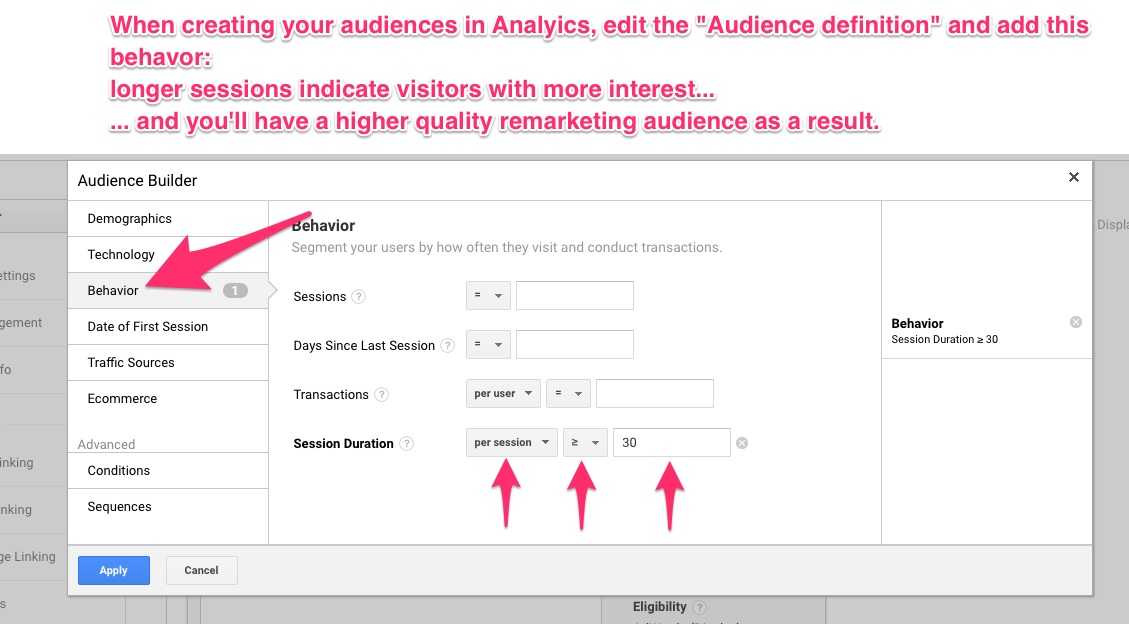Hey everyone,
I was just helping a non-profit organization with their PPC marketing and thought this tip would be valuable for you, too.
If you are using, or ever plan to use, paid traffic in the future,
. . . do yourself a favor and setup your remarketing list audiences NOW.
Why now?
Because the audiences can be filling up as soon as you create them, and then they are ready to go whenever you are ready to run ads.
If you’re feeling pressured, “I don’t need another things to do during this busy season!” that’s ok, you do NOT need to start the actual campaigns now.
Just start the audiences to capture the traffic that’s coming in now, especially the Holiday season traffic spikes.
First step:
– Install Google Analytics on your entire site and funnel (all pages)
– Install your Facebook Pixel on your entire site and funnel (all pages)
Second step:
Create audiences.
In Google Analytics, this is done under Admin > Property (middle column) > Audience Definitions > Audiences
[Pro Tip for Analytics] you’ll have a cleaner audience if you apply a filter to only keep sessions that laster 30 seconds or longer. Screenshot attached below for reference.

In Facebook, in the Ads Manager, go to the menu in the top left corner > expand the full menu by clicking “All tools” > over in the “Assets” column choose “Audiences” > “Create Audience” > Custom Audience > Website Traffic.
[Pro Tip for Facebook] I also recommend you come back and create audiences under “Engagement” : people who’ve engaged with your Page, Posts or Ads on Facebook even without visiting your website
I recommend you create a set of time-based audiences, generally:
Facebook:
7 Days
30 Days
180 Days
Analytics:
7 Days
30 Days
180 Days
365 Days
540 Days
Why 540 Days?
Glad you asked 😉 that’s what caused me to write this post:
The account I’m working on right now is for an annual event and their biggest audience is 1 year. That’s a mistake I made myself during setup last year.
That means I cannot show ads to the people who visited before the event last year, which is exactly who we want to show ads to right now. 🙁
And you’ll be in the same condition next year if you have holiday traffic: in December (and especially the later in the month it gets) you’ll want to be showing your ads to the people who came to your site in October-November-Early December this year. But if your biggest audience is 1-year, you won’t be able to do this.
So consider 540 days to be a time capsule of traffic for next year.
Why 7 days?
Its your best quality traffic, following Perry’s RFM principle. (3D 80/20)
Why 30 Days?
In January when sales are slow you can retarget all the people who visited during the holiday shopping season.
Should I do even more?
Only if you have enough actual traffic to warrant fine-grained subdividing of segments.
In a perfect world on a high-traffic site, you’d have lots of early segments (something like 1, 2, 3, 5, 7, 10, 15 days) and show different offers (different ads) to those groups in succession, like an auto-responder sequence.
But I find that 80% of sites don’t have enough traffic to actually do that, in fact most sites can’t fill up a 3 day audience and many can’t fill anything less than 30 days. (Google and FB require a certain minimum amount of people in the audience to actually run ads to them)
Third step:
Link your Google Analytics account to your AdWords account so they can share data.
If you have a Search Console account, link it too
(You do have a Search Console account, right? Its the only way to interact with Google about the organic side of your website.)
Hope this helps everyone have more successful marketing campaigns this season and happier holidays to go along with it.
Feel free to ask follow up questions and I’ll reply when I can. Its a busy time of year 🙂






